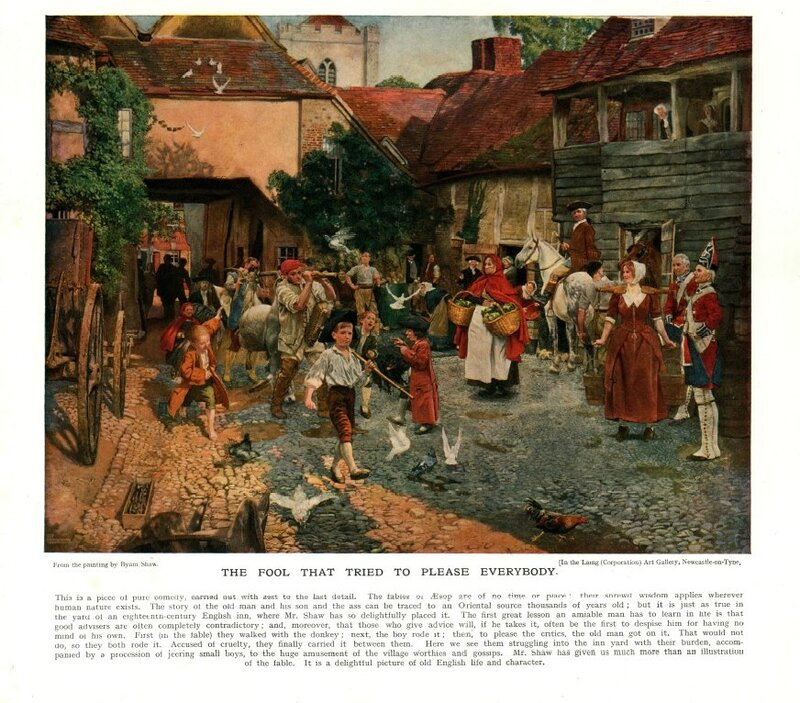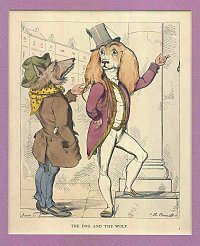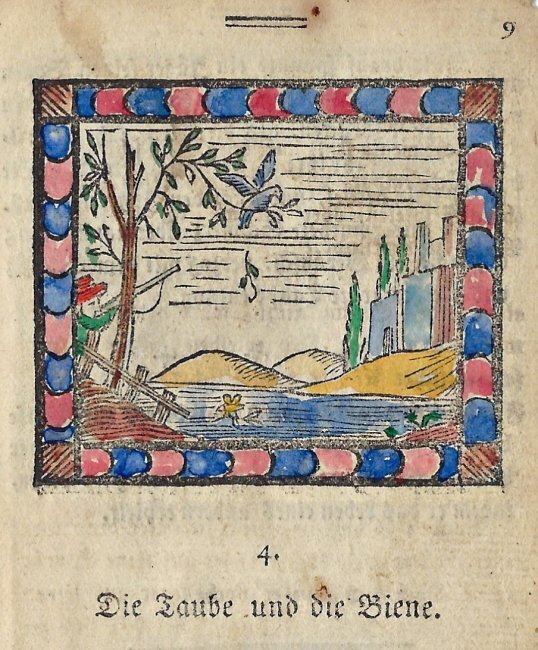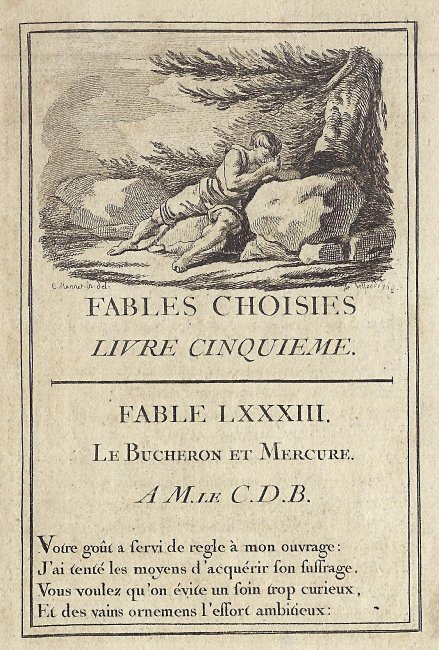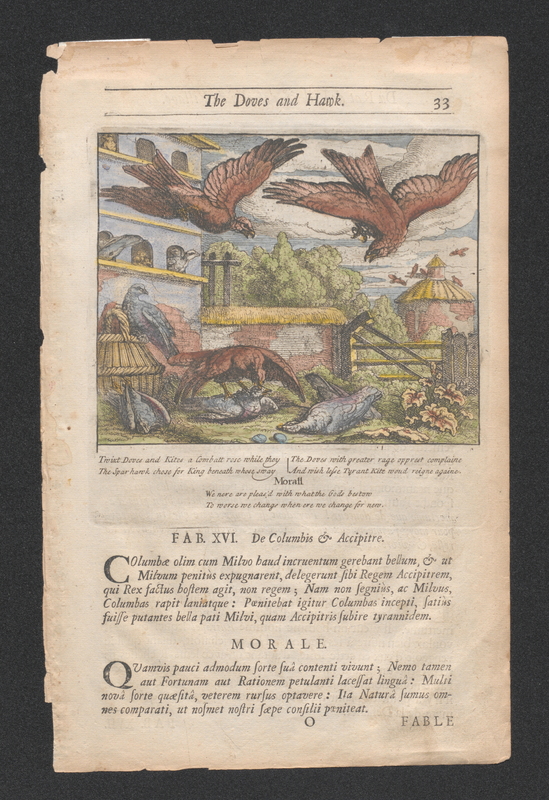Separated Book Pages
Our collection includes a large set of separated pages from Francis Barlow's 1687 second edition, from the 1768 edition of Etienne Fessard, and also a variety of individual separated pages.
-
Eleven separated book pages offering art by David Frankland1983 Eleven separated book pages offering art by David Frankland. Most probably taken from Aesop's Fables as published by Hamlyn in England in 1983 and by Silver Burdett in the USA in 1986. $14.16 from BurkeSevenVintage, Steinbach, Canada, through Etsy, July, '20. The indication that these are separated book pages comes in the texts of other fables on the verso of each illustration. I hope these were taken from a book in terrible condition that had no other use left. See my comments on Frankland's art under the books themselves.
-
"The Mice in Council"1920? BC. 8.5"x11" page (47) from an unknown magazine or encyclopedia presenting "The Mice in Council," illustrated by D. Hine. $16 from Rick Meyers, Muskegon, MI, through Ebay, July, '99. An elaborate broad margin-design of cat and mice surrounds a title balanced by an image of the cat looking down, a half-page of text, and an image of one mouse wearing spectacles speaking to a group of mice, one of whom holds a bell. The text, including moral, seems lifted verbatim from James. The article on the back of the page gives women advice on how to test textiles.
-
"The Fool that Tried to Please Everybody."1912 "The Fool that Tried to Please Everybody." Illustration by Byam Shaw and text on p. 21 in "Libby's Annual" for 1912. $13.50 on Ebay, Dec. 20, '06. The original painting, according to the article, is in the Lang Art Gallery. Shaw died in 1919. The painting is a more detailed presentation of MSA than I believe I have ever seen elsewhere. Libby's comment is excellent. This is a piece of pure comedy, carried out with zest to the last detail. The fables of Aesop are of no time or place: their shrewd wisdom applies wherever human nature exists. The story of the old man and his son and the ass can be traced to an Oriental source thousands of years old; but it is just as true in the yard of an eighteenth-century English inn, where Mr. Shaw has so delightfully placed it. The first great lesson an amiable man has to learn in life is that good advisers are often completely contradictory; and, moreover, that those who give advice will, if he takes it, often be the first to despise him for having no mind of his own. First (in the fable) they walked with the donkey; next, the boy rode it; then: to please the critics, the old man got on it. That would not do, so they both rode it. Accused of cruelty, they finally carried it between them. Here we see them struggling into the inn yard with their burden, accompanied by a procession of jeering small boys, to the huge amusement of the village worthies and gossips. Mr. Shaw has given us much more than an illustration of the fable. It is a delightful picture of old English life and character.
-
DLS1900? DLS This appears to be a book illustration cut out with no identifying marks left. The perspective is unusual. The owner approaches the shaggy-dressed donkey menacingly with one hand behind his back and a club in the other hand. I have no idea where I got this picture!
-
Matted hand-colored illustration of DW1870? Matted hand-colored illustration of DW, a page from an edition of Charles Bennett's fables, engraved by Swain. $20 from John and D'Ann Stone, The Bay Window Print Locker, Florence, OR, through Ebay, July, '99. The colors are excellent, down to golden buckles on the natty dog's shoes. The red-polka-dotted golden scarf of the Wolf is also well rendered here. Painting a Bennett scene brings up some good questions. I have, for example, noticed the hands of both animals for the first time. Might I be noticing them because they are the only flesh-colored items in the picture?
-
Portrait of La Fontaine1800? Portrait of La Fontaine. Blanchard sculp. I found this torn-out frontispiece of a small (5" x 3.25") book in a book recently purchased. While it follows the standard presentation of La Fontaine in such frontispieces, here his nose seems large and the picture's impression is unusual. The oval portrait is surrounded by geometric forms filled with printer's lines.
-
Aesopische Fabeln für die Jugend Nach verschiedenen Dichtern gesammlet und bearbeitet1803 Aesopische Fabeln für die Jugend Nach verschiedenen Dichtern gesammlet und bearbeitet. A.G. Meissner. Neue mit 150 Holzschnitten versehene Ausgabe. Hardbound. Prag and Leipzig: Martin Neureuter. €150 from Hatry, Heidelberg, July, ‘25. Here is one of the loveliest and most curious finds from summer days in Europe in 2025. 3.75” x 6”. About 340 pages. It consists of five books of 30 numbered fables each, plus an appendix of three more fables. The title-page advertises 150 woodcuts. The page number “195” is inverted, and “299” comes out “929.” Each fable is illustrated with a framed rectangular woodcut. This book is not in Bodemann, and Neureuter does not appear there. Meissner on the other hand did various kinds of editions. Our book consists now of three sections. A portion as originally bound in boards is in correct page order but with many gaps. It stops at the title-page for the fifth book. Two other portions are made up of separated loose pages, all with woodcuts on their right-hand page. One group of these consists of 38 loose pages from various places in the book. The other group consists of 15 loose pages with beautiful hand-colored illustrations. I find these wonderfully done! I presume somebody took the time to illustrate these pages, and somehow they have lasted 220 years! I will list this book under both “books” and “separated pages.”
-
Etienne Fessard, Vol. III, 17681768 A set of pages removed from Volume III of Etienne Fessard's edition of La Fontaine's fables. Pages represented are 1 (the beginning of Book V: Fable LXXXIII) – 14; 17 – 24; 31 – 32; 35 – 42; and 51 - 56. $49.99 from Biblio Emporium through Ebay, August, '20. Here is a set of pages taken from Volume III of Fessard's monumental six-volume edition of La Fontaine's fables, according to Bodemann the first fully illustrated volume. The pages were sold as coming from 1768, but the name mentioned in its advertising was Charles Monnet and the description was "chapbook." I gather that the difference between Monnet and Fessard represents the age-old tension between artist and engraver. In any case, I was so delighted with these illustrations that I scanned them all and present them here in smaller and larger versions. Not every fable represented here has both its full title illustration and its endpiece.
-
Barlow 1687 Hand-Painted Leaves1687 Eight hand-painted leaves from Francis Barlow’s “Aesop’s Fables with his Life,” second edition. $400 from girlbookseller75 on Ebay, June, ’25. These are exquisitely painted leaves! I look forward to showing them off together with our first edition Barlow from 1666. My two favorites among them are DS and “The Eagle and the Crow.” And I love the face of the old woman looking out the window as the two girls kill the cock. Notice the error on 213. The page’s title is “The Stag Looking into the Water.” That fits with the Latin text and moral, which were presumably printed together with the page’s title. But the illustration is for a different fable, “The Master’s Eye,” about a stag hiding in a stall and eluding notice until the master enters the barn. The English text, printed with the illustration, is the correct one for “The Master’s Eye.” Several of the illustrations are printed slightly askew on the page. Beautiful work!
